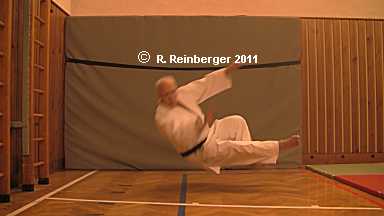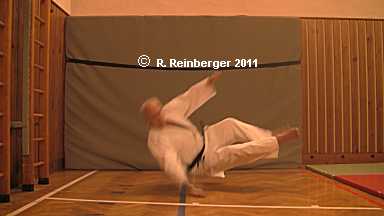|

|
Ukemi
| |
Please be aware of the fact that I'm not a jūdō yūdansha.
Therefore, your nomenclature as well as your techniques may vary from my jūjutsu
style. However, I think the points I'm making here do also apply to (Kōdōkan)
jūdō ukemi. |
|
|
 |
|
Zenpō kaiten ukemi,
1972 |
|
Chūgaeri, 1972 |
Ukemi off the tatami: if you want to try it, please start with performing every waza
in the very slowest and lowest way possible, in the most easy format you would
use when introducing the respective technique to a beginner in normal class.
You can always upgrade later, if you are more familiar and confident with
taking the falls at a hard surface.
While I'm training this for many years now, I still don't do
it with the same impetus and force, or from the same heights as I use to do it
on the
tatami. As you will notice I'm no longer at my ideal weight, like I used to be
decades ago, which makes the thing more forceful and therefore more difficult.
Moreover, and most importantly: I don't want to injure myself, while training how not to
injure myself!
In the meantime, I do most of my
ukemi in the fashion shown below, even if I practice on the tatami. I think,
that provides the best chance of internalization and automation.
Now, here is some of what I do
at any rate, when I'm training ukemi off the
tatami (we call it "Harte Fallschule" in German language):
1. Mae ukemi
a) Zenpō ukemi
|
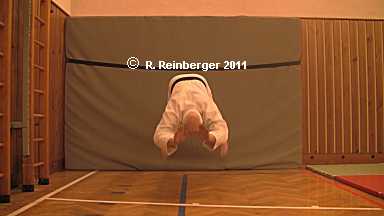
|
In midair
|

Videoclip
|
I make VERY sure that my hands and forearms land
WAY BEFORE the elbows touch the ground. Otherwise I very
probably would injure my elbows.
By tautening my hands and arching the finger(tip)s up as much as
possible, I also make sure that my palms slap the ground first, and
much more then the fingers. As one of my yūdansha students - an emergency
doctor by profession - as well as I myself had experienced, the
blood vessels especially in the lower part of the fingers tend to
burst if you slap the ground with to much force and with your
fingers involved.
I use this type of slapping with every ha uchi I
perform.
|
b) Chūgaeri
|

Videoclip |
Here is how
I do chūgaeri. My deeper exploration of ukemi started with an
injured ankle. Since then, I stretch out, and, above all, tauten the
leg at the side on which I land, to prevent the ankle from hitting
the ground.
Otherwise the anklebone would
hit the ground with enough force to injure, or even break it.
I also tense the subtalar joint of
the other leg, which takes much of the impact of this technique, in
order to prevent my heel bone from injury possibly caused by a hard
clash on the floor.
Of course I do the ha uchi as
described above. |
c) Zenpō
kaiten ukemi
|
Videoclip |
My zenpō kaiten ukemi following
the same guidelines, isn't much different from the ordinary form.
|
|
Videoclip |
I
also do some other type of zenpō kaiten ukemi, but using
it it's more difficult to protect the ankle, and not at all possible
to do it in the manner described above. However, as I think this
kind of roll is considered obsolete, or, perhaps, even "wrong"
in (Kōdōkan)
jūdō, I refrain from depicting it further. |
2. Yoko ukemi
3. Ushiro ukemi
a)
Kōhō
kaiten ukemi
|
I do my Kōhō
kaiten ukemi pretty much in the same way on and off the tatami.
Therefore I didn't take video, as I thought it to be unnecessary. We
start the backward roll similar to the standard jūdō
ushiro ukemi, but we try not to do it in a straight line, but
rather diagonally, like a forward roll, but this time starting
from one side of the bottom to the other side's shoulder. |
b)
(Ma) Kōhō
ukemi
|
Videoclip |
This is how we do a
backward fall. Again, it may not be relevant for
jūdōka.
|
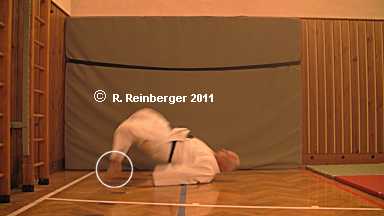 |
Here a similar final
position is the result of a different technique. In fact, the way it
is achieved puts the technique in the Mae ukemi category. Of course
I don't do this somersault in the air, like I perform it on tatami.
While I think you don't use this in (Kōdōkan)
jūdō, it illustrates very good the function of the stretched and
tensed subtalar joints: both feet land on the balls of the feet, instead
of the whole soles including the heels, or even on the heels alone,
transferring most, if not all of the kinetic energy developed during
the fall to the heel bones in this way. |
|
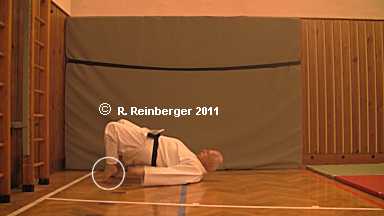
Videoclip |
As the subtalar joints
are still stretched and tensed, the heels go back into the air after a
rather soft impact. The joints had worked like spring systems, and
with that had protected the heel bones. That's the same principle as I have described
with chūgaeri. |
I hope that some of this at
least was
of interest for anyone apart from me.
|





